The first game that we all think about when the name Jason Matthews is mentioned is invariably Twilight Struggle. This was his first published design and it was a collaborative effort with Ananda Gupta. Twilight Struggle is probably his finest design and is such a great game with its asymmetrical struggle between the titanic Super Powers of the United States of America and Russia for the fate of the world during the Cold War. But there is much more to his design talents than just this and he is hardly a one-trick pony. In this edition of the Best 3 Games with….series, I want to share with you a few of my favorite designs from Jason Matthews. I will not be including Twilight Struggle on this list! We all know it is amazing but I am excluding it here.
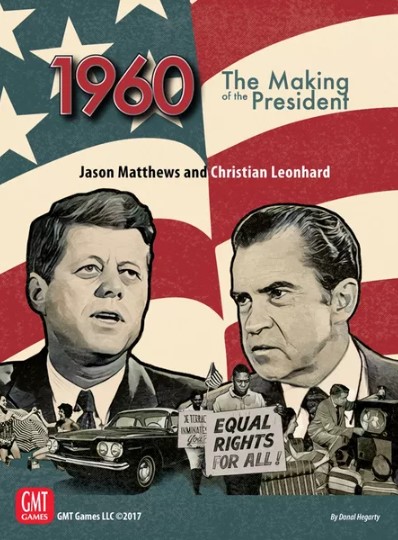
3. 1960: The Making of the President from GMT Games
Elections are often a period that many people don’t look forward to. They’re a time of great policy upheaval and political discussions, as well as a glut of annoying tv commercials, which can polarize many. It’s not really a theme I would intuitively slap on a board to sit down and play for fun on a weekend or evening, but 1960: The Making of the President had me intrigued from the start.
1960 isn’t a new game having been originally published in 2007 and then having a 2nd Edition in 2017. Card Driven Games are one of my favorite types of games, as there’s simply something really rewarding about the hand management puzzle you have every turn in conjunction with the game board at large. CDG’s do a really good job of presenting you with difficult resource management problems, without getting extremely dry, mechanical and overly mathy. Counting and recounting cubes or resource chits isn’t really my idea of fun, and too much book keeping slows a game down and can break the back of the game in my mind. 1960 doesn’t do that in any way. The cards look a little busy, but they’re actually beautiful and very simple to understand once you get the basics down. They use a CP value that can be utilized to put colored wooden cubes on the board for influence in various states, in the media, or with key political issues. The other major option is to utilize them for their events. The events are almost all self explanatory and in a deck of over 100 different cards, that’s a pretty nice feat.
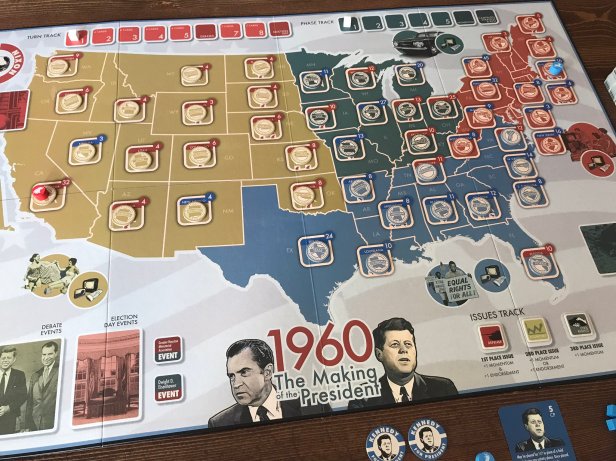
The other things you do with the cards are storing them away in the “Campaign Strategy” pile, which means they’re used during the debates phase to win issues, or on Election Day they give you valuable support checks that represent wild voting in swing states. Basically, the card mechanics are very familiar if you’ve ever played any kind of CDG, but they’re extremely clean, and fairly simple to understand. The hand management doesn’t make you want to pull your hair out and the struggle between deciding on playing cards and storing them into the campaign strategy gives you a cool extra level of strategy but won’t leave you with hours of analysis paralysis.
1960 is a game that has a lot of ebb and flow to it. Being a CDG you do get a lot of the same feelings that you do in games like Washington’s War or Twilight Struggle, but the reality is, is that there is far less stress. For me, Twilight Struggle feels like every territory is a tug-of-war and that every single point is worth fighting a small war over. In 1960, the people’s minds are fickle, and their opinions sway so often that it takes some of the edge out of it. You’re playing something more like whack-a-mole where you’re furiously blazing the campaign trail to try and curry favor, and keep it, with every State. You know this is an impossible task. But you try it anyways. Where you once had a strong lead, after the play of a key card or two now suddenly has swung the other way, but it’s okay, because you just took two other swing states away from the opposition and he is feeling the same concern as you. And so it goes.
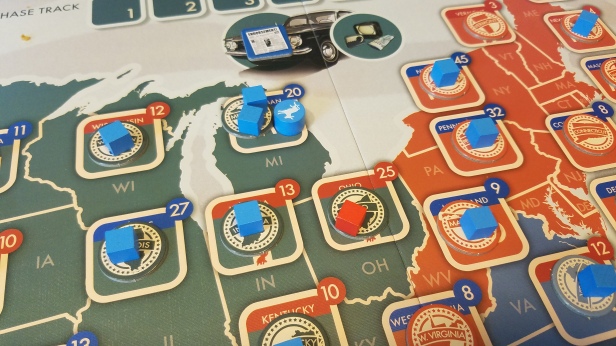
We found that as much campaigning as there was in each of the states, that vying for regional influence with the media was also very important. Media support enables you to altar the positioning of the issues track. Having influence on the issues themselves provides bonuses in the form of endorsements or momentum markers based upon their position on the track. Why do you need endorsements and momentum? Endorsements will swing neutral states in the given region to your side on election day, obviously very powerful. Momentum markers are used to trigger events that benefit you which are played out of your opponents hand for the CP’s.

I loved this mini economy/resource management aspect to the game, it was also a breath of fresh air compared to some other CDG’s. Labyrinth and Twilight Struggle just punish you for having opposition events in your hand. It feel awesome at times, that level of tension and stress, but I swear that games of Labyrinth shave years off my life. The opposite end of that was Wilderness War where no events for the opposition ever triggered. This gave a very different feel to the game where I didn’t really care about my hand, it was purely a numbers game, and I think I liked that less. The hand management is one of my favorite parts of Card Driven Games.
This is a fantastic game. It’s an accessible CDG with some really nice strategies. It’s not particularly take-that or in-your-face, but there’s a little bit of that if you want it. The rules are simple enough, and the game plays in 2 hours. That’s not a GMT 2 hours (read: 4 hours) but a start to finish 2 hours. The game is paced perfectly for the topic. I don’t want to spend any longer playing an election game, but the fast pace means the whirlwind of the campaign trail never dulls. Just a really fine effort by the designers and this has earned its place on this list!
Here is a look at our video review:
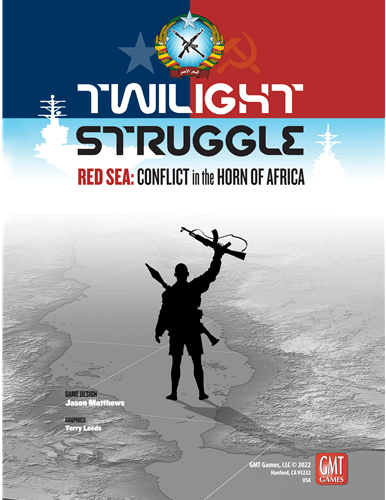
2. Twilight Struggle: Red Sea – Conflict in the Horn of Africa from GMT Games
We all love Twilight Struggle….and if you say you don’t, you really do but just want to be different or are a contrarian! The game is phenomenal and has done very well for GMT Games with 8 Printings as well as the Turn Zero Expansion and now a series of smaller geographically focused spin off games starting with Twilight Struggle: Red Sea – Conflict in the Horn of Africa. Twilight Struggle: Red Sea deals with just two regions located in the Horn of Africa including Africa and the Middle East. The game uses the familiar Twilight Struggle formula of Cards with both Events and Operations Points that can be used by players to perform Coups, do Realignment Rolls or place Influence in an effort to gain control of the most Countries in the Regions to score Victory Points and win the game. The game is fast, furious and only lasts 2 hands of cards (unless you choose to play the special 3 Turn variant) so there isn’t a lot of time to mess around and players must be focused on what they are trying to accomplish. The best thing about the game is that it plays in 45 minutes as compared to 3-4 hours for Twilight Struggle.
I was a bit nervous about the use of the Twilight Struggle System in a smaller geographically specific locale, especially in the Horn of Africa. One of the things that makes Twilight Struggle so grand is that it is an all engrossing global conflict that focuses not on one specific area of the Cold War but covers it all and assigns a tangible numerical value via the different scoring values assigned to the regions. In Twilight Struggle, Africa is a less important area than say Europe, Asia or even the Middle East based on the scoring for the Region. But shrinking the game down to a smaller geographic area worked just as well as in the big game. It provided the opportunity for the designer to include historically significant events to the game that directly affected the Horn of Africa/Middle East but that fit well into the larger global Cold War setting and conflict. Some examples of this were the Neutral Card Famine, which provided the player with the choice of placing Famine Markers into a few adjacent countries. The Horn of Africa has to deal with severe drought and high temperatures that often lead to crop failures and the loss of livestock. This results in regular famines that accost the land and the Cold War powers tried to use this to their advantage by trying to convince the local populace that they could do better at managing those negative effects than their opponents. I really enjoy these type of thematic connections in the cards found in Twilight Struggle: Red Sea. They reinforce the propaganda and tactics of each super power during this titanic world ideological struggle.
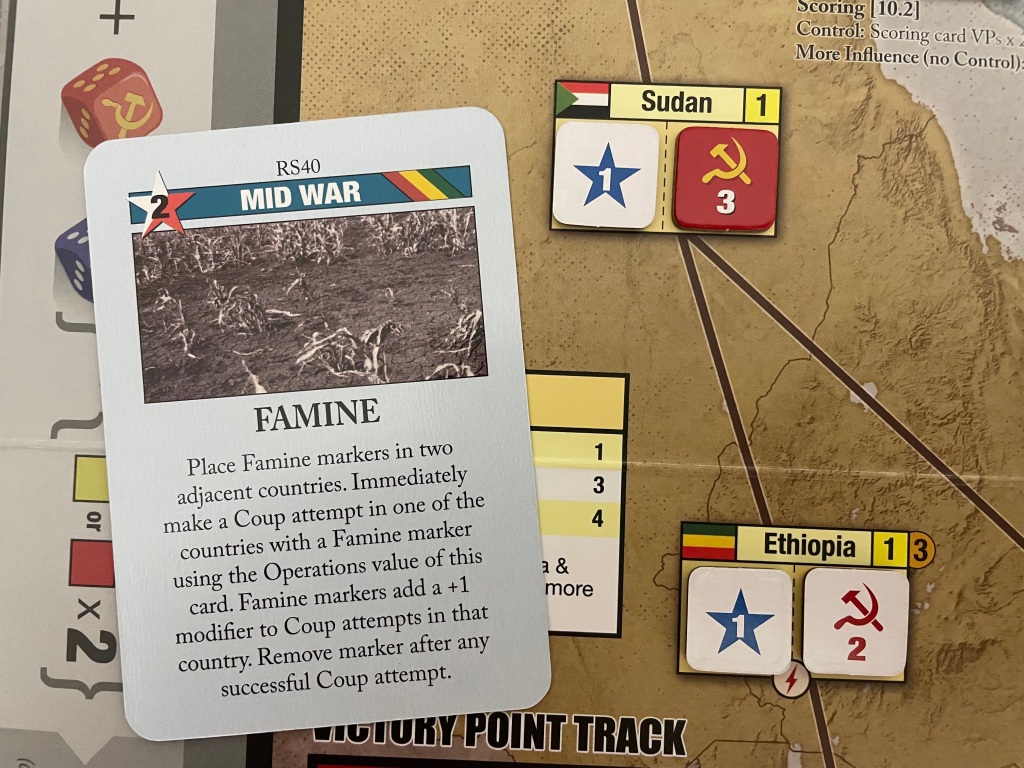
Another great example of the scale of the conflict being localized is the Neutral Card Water Wars, which refers to the age old struggle between Egypt and Ethiopia for control of the Nile River as a primary water source. Over the years, dams have been built which lead to the restriction of water to Ethiopia and the argument continues. The card allows the player playing it to remove all of their Influence in either Egypt or Ethiopia depending on which has the highest value. This can be a very important card if one player has built a lead in Egypt. Egypt is a Battleground Country and is very important to scoring.

One of the things that I was immediately impressed by when we first played Twilight Struggle: Red Sea – Conflict in the Horn of Africa, was the fact that it was not just a reskin of Twilight Struggle. This game was a smaller, faster playing, more tightly focused regional look at the Cold War and the struggle for control of Africa and the Middle East as I have espoused above. But it was more than that as it really had integrated some new mechanics and tricks into the design that have created a new focus and new tension for the players. These new elements don’t make large sweeping changes to the core of the game, but do add some interesting new twists to give a new and fresh experience without taking away the essence and feel of the original classic Twilight Struggle.
Strategic Sea Lanes are a very interesting new addition to the game that changes how scoring is completed without adding a lot of new rules and overhead. It is just an additional way to create some really palpable tension and other battlegrounds for players to have to worry about and focus their strategies upon. The Strategic Sea Lanes Box is a space found on the board but it does not represent a specific physical location. It is not a Country and is not connected to any other Countries. It has special rules for Influence Placement and Scoring.
So how does it work? Strategic Sea Lanes are scored when a Scoring Card is played and will have a major impact on the resolution. In order for the Strategic Sea Lanes to be scored, one of the players must Control the space. In order to Control the space, the player must simply have Influence equal to the Strategic Sea Lanes Stability Number, which is 4, while also having at least 4 more Influence in the space than their opponent. Basically, the Strategic Sea Lanes space works the same as every other Country on the board. In the picture below, the Soviets have a total of 2 Influence in the Strategic Sea Lanes space as compared to the United States’ 2 Influence. The Soviets DO NOT Control the space as they don’t have at least 4 Influence to equal the space’s Stability Number nor do they have at least 4 more Influence than the United States. In this example, in order to Control the space, the Soviets would need a total of at least 5 Influence there.
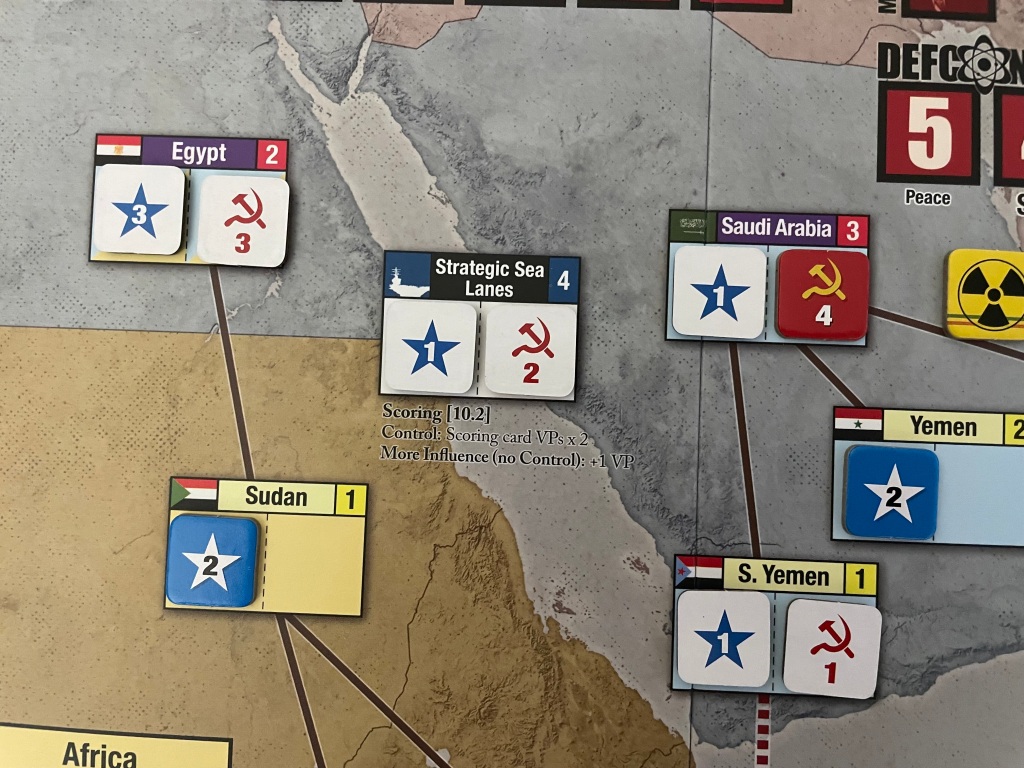
When a player Controls the Strategic Sea Lanes space, the effect is that this will double the Victory Points they will receive when resolving a Scoring Card. Also, the player who has more Influence than their opponent in the Strategic Sea Lanes space when a Scoring Card is played, but does not have sufficient Influence to Control the space, will receive 1 VP. And that is it…a pretty significant benefit that will lead both players to fight fiercely over Control of this space! I really like this inclusion as it simply adds something else that players have to think about and monitor as you cannot allow your opponent to get ahead in this space.
Another addition to the game was the concept of Flashpoint Countries. 2 of the Countries in Africa are classified as Flashpoint Countries and you will notice a new symbol appears in both of their boxes. This red lightning bolt icon indicates that these 2 Countries are Flashpoints, and are distinct from Battlegrounds. The Ogaden War is a central focus of Twilight Struggle: Red Sea and both Ethiopia and Somalia work differently than in Twilight Struggle.
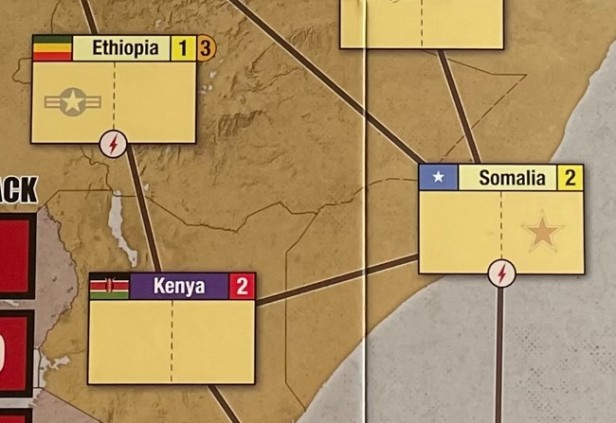
The real distinction here for Flashpoint Countries is that Coup Attempts against either Ethiopia or Somalia are conducted slightly differently. When a Coup Attempt is made against a Flashpoint Country, a card is turned over from the top of the draw deck. If it is a Scoring Card, a 1 Op Value or a 2 Op Value Card, the players will then decrease the DEFCON Status by 1 level and then this drawn card is discarded. This action could potentially trigger game-ending global thermonuclear war. Additionally, if the drawn card happens to be a Scoring Card, it will be resolved immediately before the Coup is resolved. If the drawn card is a 3 Op Value or 4 Op Value Card, it will not be discarded but will be placed on the bottom of the draw deck but otherwise will have no effect. In the picture below, the United States player initiates a Coup Attempt against Ethiopia and draws a 1 Op Value Card, which will be discarded but will lower the DEFCON Status Track by 1.
After a few plays of the new Twilight Struggle: Red Sea, both Alexander and I were really impressed with the overall depth of the game, the different feeling of the game but also the fact that it still feels like Twilight Struggle. I didn’t want to see this become a totally new game but just to have some new feeling to add to the legacy of the system. And I think that Jason has done a fantastic job here of doing exactly that. I also love the fast and furious nature of it as with just 2 Turns (3 if you play the extended games), you have to make progress quickly and also slow your opponent or someone can run away with it. I absolutely love the feeling of TS: Red Sea and cannot wait to play more but also to experience what is in store for us in the future expansions to the system such as the newly announced Twilight Struggle: South Asian Monsoon.
Here is a look at our video review:
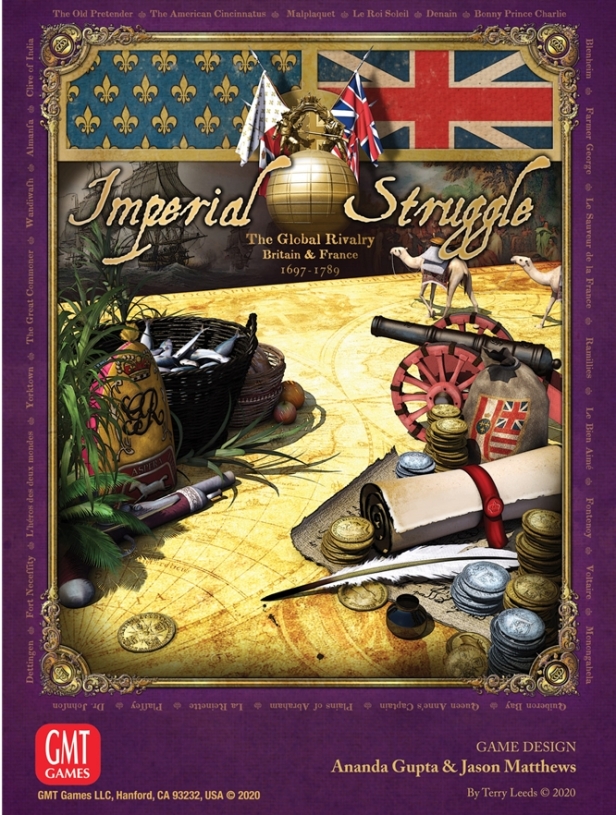
1. Imperial Struggle: The Global Rivalry – Britain & France 1697-1789 from GMT Games
A few years ago, we were able to acquire and play Imperial Struggle which is the newest partnership between Ananda Gupta and Jason Matthews that deals with what historians refer to as the Second Hundred Year’s War and covers the period of 1697 through 1789 stretching over four different wars. The game uses cards and Investment Tiles to allow the player to take various actions that change their fortunes across the globe with diplomacy, economic growth, and if all else fails war. Players will score Victory Points from the domination of Regions, controlling various Markets and from victory on the field of battle. There are so many options and strategies available in this game that it makes for a very deep and lasting experience that only gets better with time and more plays.
And in my humble opinion, the game is even better than it’s predecessor Twilight Struggle. Very different, but better. I didn’t think that was possible but it is. I still like Twilight Struggle a lot but this game fills a whole new niche and I have really enjoyed exploring it. Imperial Struggle uses a very interesting limited action selection mechanic where the player can choose from a number of Investment Tiles to take two different Actions called a Major Action and a Minor Action during one of their four rounds each game turn. I say limited action selection because there are three different types of Actions in the game including Economic, Military and Diplomatic and only two of these can be taken each round. These Investment Tiles each contain a top portion and bottom portion with a different Action listed as well as a number of Action Points identified that can be used for those Actions. Therefore, each round a player will only get to take two different Actions from the three available and these choices will be limited by the number of Action Points the selected tiles convey.

The players will alternate choosing from the available Investment Tiles found in the Investment Tile Display and once used the tiles will be placed in the Used Investment Tiles Box. At the beginning of a Turn, there will be 9 of these Investment Tiles laid out to choose from and once chosen the spaces are not refilled until the next Turn. Therefore, the players will have to choose from what is available for the round and make the best use of the Actions there to execute their strategy.
Advantage Tiles are another new addition to the system and they really create some interesting opportunities for players. These Tiles are obtained by controlling all of the spaces that connect to their location on the map. Once controlled, the controlling player will place that Advantage Tile on their player board and can use it’s ability to influence future Actions. The moment that the player loses control of any of the connected spaces on the map to the Advantage Tile through a change in control of a space or losing their flag, the Advantage Tile is returned to the map and the space will have to be controlled again to gain the Advantage Tile back. The Advantage Tile also cannot be used by the controlling player if there is a Conflict Marker found in any of the connecting spaces. The Conflict Marker doesn’t force the player to return the Advantage Tile to the map but they cannot use it’s ability until that Conflict Marker is removed. This is very thematic as the advantages are sometimes tied to peace in order to work, such as industry, agriculture or alliances.
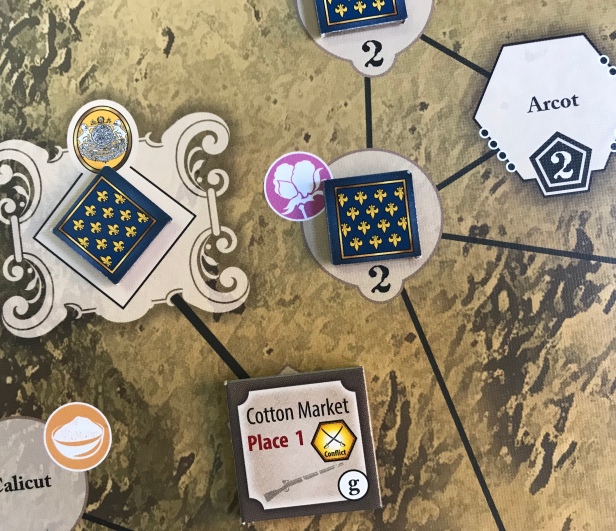
So what do these Advantage Tiles offer to the controlling player? Advantage Tiles are simply tiles with special abilities that can be used by the controlling player once per Game Turn. The player will mark the tile with an Exhausted Marker to denote it has been used and then will enact the benefit. These Advantage Tiles can be used at any time during a player’s Turn but may not be used on the same Action Round that it was obtained from the board. A player may only activate two Advantage Tiles per Action Round and may not use more than one in any Region. Some of the Advantage Tiles allow the player to place out Conflict Markers, which cause lots of negative effects for their opponent in the spaces placed in such as not counting towards Domination of a Region or scoring for Markets.
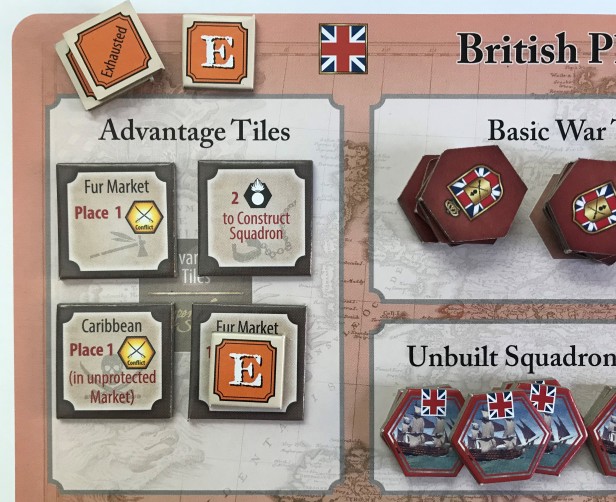
They also offer discounts to certain Actions but will require the player to spend the appropriate Action Points such as with Diplomatic Actions or Military Action benefits, the player will have to spend either Diplomatic Action Points or Military Action Points to get the benefit. Seems logical to me. It is important to remember that when utilizing the special abilities of the Advantage Tiles that the costs in AP’s to effect a space can never be lowered to below 1.
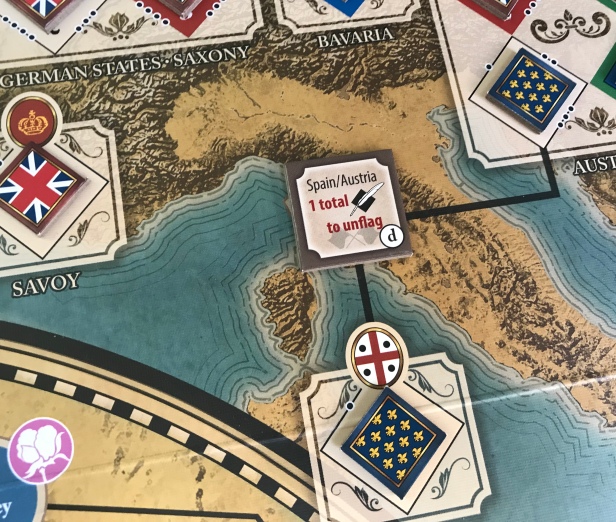
Now that you have an idea of how you utilize the Advantage Tiles, let’s take a look at a few of the different tiles available. Below is a picture showing 5 different types of Advantage Tiles that offer the ability to manipulate the costs of Military Actions, reduce outstanding debt, reduce the costs of Unflagging an enemy space and placing Conflict Markers in certain specific Regions. As the player is developing their strategy, they should pay attention to the different Advantage Tiles and plan to obtain the ones that fit well with that strategy. There are a lot of different tiles to choose from as there are 22 tiles placed on the map at the start of the game.
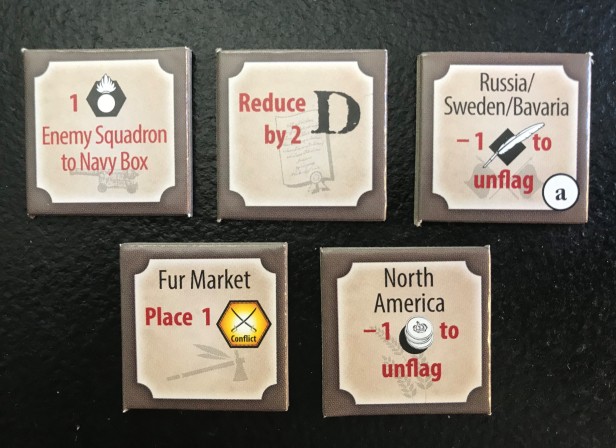
If you have played Imperial Struggle’s predecessor game Twilight Struggle, you know that cards take a major role in that game about the struggle for control of the globe between the United States of America and Russia. The cards have both Events and Op Points that can be used to take various actions and play revolves around managing the players hand of cards. The cards are used very differently in Imperial Struggle though and can best be classified as assisting the game but not driving it. Furthermore, the cards are tied directly to the Investment Tiles which are the main engine of the game. When a player takes an Investment Tile, they may take all of the actions on the tile in any order, except that if the tile allows an Event to be played, the Event must happen before any other actions are taken.
Event Cards are the basic element of the game that injects the historical timeline into the gameplay. The Event Deck contains cards that represent different historical events that can benefit one side or the other. When play progresses into a new Era this will trigger the addition of new Event Cards to the deck. The starting cards for the players are those that are marked with a white colored bar along the left edge of the card with the word SUCCESSION printed at the bottom left of the card. Then follows the EMPIRE cards and finally the REVOLUTION cards. At the start of each turn, players will be dealt 3 Event Cards.

One of the more interesting design choices revolving around the Event Cards is that the cards will typically display two versions of the same Event, one that is pro-French while the other is pro-British. One of the Events is the actual historical event as it happened and how it effected the struggle, while the other is a what-if type scenario that adds in some interesting ahistorical happenings. I really like this aspect as it is kind of like playing that game “2 Truths and 1 Lie” as you don’t really know which one is the historical version and as such you have to do some research to find this out. On these cards, the top section is always the pro-British Event while the bottom is the pro-French. A player may not play the version of the Event that is associated with their opponent. Some Event cards show only one version of the Event and these are played the same way by both sides.
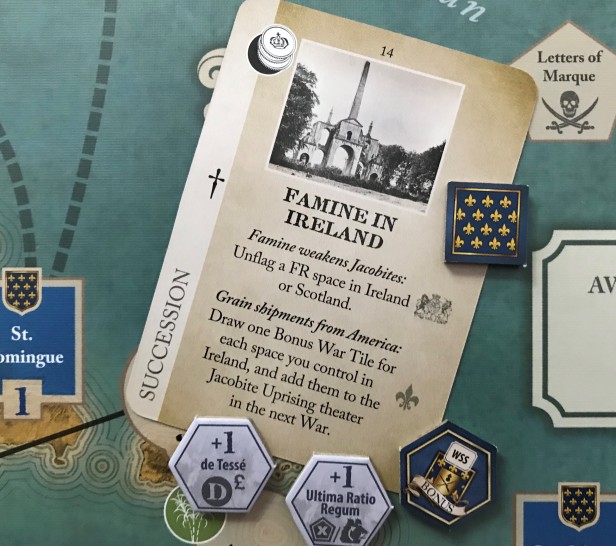
Most of the Event Cards also show a Bonus Condition. These Bonus Conditions will provide the player an extra benefit if the Bonus Condition is met when the card is played. Along those same lines, some Event Cards have restrictions that may prohibit the card from being played. Some Event Cards show a specific investment type and those Events cannot be played unless the selected Investment Tile has an Event symbol and its Major Action matches the Event’s investment type. So playing these Event Cards can be a challenge as you have to work toward being able to play them in some instances. But, this planning assists the player in taking a strategy and trying to make their chosen actions more powerful and rewarding.
The Bonus condition is typically, but not always, met with the Ministry Cards that a player has played face down at the beginning of their turn. For example, in the below picture you will see that Jonathan’s Coffee-House has listed as its Bonus condition Finance. If the player has a facedown Finance Ministry Card they will then gain the bonus. They then have to reveal that Ministry Card. Normally, the Event Card provides 2 Economic Action Points but if the Bonus Condition is met the player will receive 1 additional Economic Action Point and also will be allowed to reduce their Debt by 1. I have found that these Bonuses are very important and can make the difference between a good turn or a great turn. I wouldn’t encourage anyone to spend a lot of time choosing their Actions each turn around the Bonus Conditions though as this could lead to you not doing those things that are best suited for your strategy and the current board state. But when all things align and the Bonus Condition is meat it can be really great and make a big difference.
This design is so good as it tries to tie in so many different moving parts and does so seamlessly to create a divinely interesting and strategic play experience. I love that the cards in Imperial Struggle are used completely differently than Twilight Struggle. They supplement the actions that players take as they choose their Investment Tiles and don’t drive the action. As we have played this one, I have thought about how easy it would have been for Jason and Ananda to simply use the same tried and true method of cards from Twilight Struggle. I mean, it worked, and plays very well and really is one of my most favorite games of all time, but now comes this implementation of the same type of tug of war struggle between empires but they use a new mechanic and introduce a new way of playing the game. I think that is just about the coolest thing ever and really give the dynamic duo a tip of the cap as they have really outdone themselves with the depth and ingenuity of Imperial Struggle. Imperial Struggle is simply a masterpiece. The game play is phenomenal and keeps players engaged over the full course of the game. You are never really out of it and can always get back into the lead if it has slipped away through the shrewd use of your Actions and the skillful choice of Investment Tiles. There are so many really interesting and meaningful decisions in this one, from what Ministry Cards you choose to use and how you plan to use them, to the choice of your Investment Tiles each Turn. You can focus on Markets and the fickle demands for those goods, or on establishing Political control of Europe, or even on dominating the War Turns through the addition of Bonus War Tiles to each theater of war. Players simply have many ways they can go about leading their nation to victory.
Here is our initial first impression review video:
Imperial Struggle is a game that I will play at anytime. Hands down. I cannot wait until our next battle for control of the globe and the tension and angst that I am sure to feel over my choices.
I hope you have enjoyed my list of the Best 3 Games…with Designer Jason Matthews! He has given us so many great games that have changed my attitude and perception of historical events and were also very fun and interesting to play. I love to play wargames but I also love to learn history and Jason’s focus on the CDG mechanic allows this to happen. He also is supremely talented and doesn’t just make the same games over and over again but is a creative innovator who tries to deepen and broaden our play experience with his designs. I have had the pleasure of meeting Jason twice; once over lunch in Washington DC with Sebastian Bae and Kevin Bertram and once at Gen Con where we had dinner together with Darin Leviloff. I own lots of his games and cannot wait for what he does next. I did see where his design United States vs. Aaron Burr is making progress and should be going to Kickstarter sometime in the near future.
Please let me know your thoughts on these games as well as those that I left off the list.
-Grant
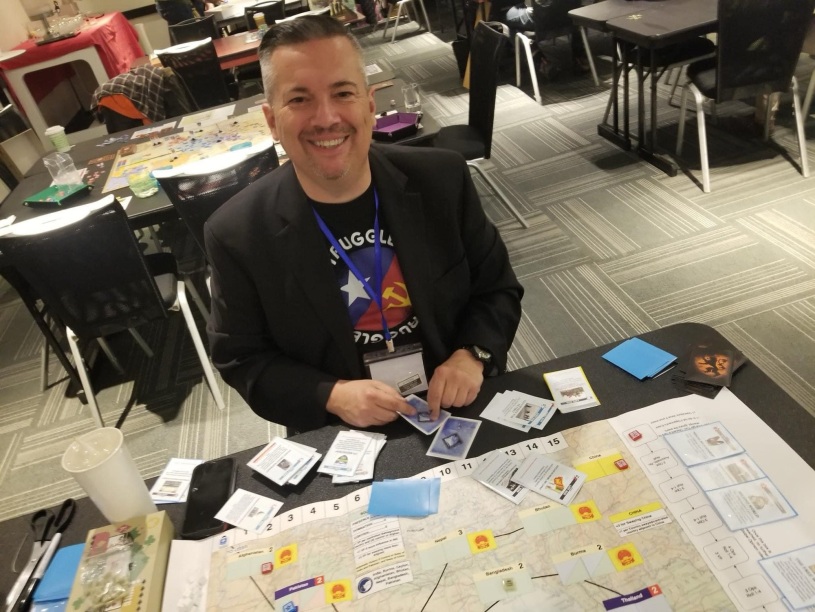
Don’t sleep on Founding Fathers, a game Matthews co-designed with Christian Leonhard. The game plays up to 5 and is set at the constitutional convention in Philadelphia with the players vying to see their political points of view enshrined in the constitution. Still card driven but it might be his simplest game.
LikeLiked by 1 person
I purchased if off of a flash sale on Amazon a few years ago but have yet to get it to the table. I also just purchased Sola Fide from Stronghold Games by him and Christian. Love his games. 1989 is so very good as well and really hard for me to keep that off of this list but there could only be 3.
LikeLike
Thanks for taking the time to highlight these three non-TS games. Your review has helped me move Imperial Struggle much closer to the table! -John
LikeLiked by 1 person
Imperial Struggle is so very different but so very good. We loved it. Need to play it some more but it is a very different and unique experience. Feels much more like a wargame.
LikeLike
100 percent agree with you Grant about Imperial Struggle – simply an outstanding design and game. Not complex – but the decisions are deep and plentiful. And it’s pretty Epic – How many games can you play on such a far reaching global historical topic in an evening?
John – after a couple of plays, it moves quickly; from my experience, most of the time is taken by the players just thinking about their decisions. Also, make sure you have the update kit from GMT or 2nd printing. It’s a really cool game.
LikeLike
The headline photo of him showing off Asian Monsoon was taken at Stack Académie in Montréal recently! He was very gracious in kicking my ass when I playtested it with him, ha!
LikeLiked by 1 person
Nice. Really looking forward to that one. I just live the smaller regionally focused games in the system. Hope to see a few more come out. All in good time!
LikeLike
I really enjoyed my plays of Imperial Struggle, and when I see Jason’s name attached to a project, I definitely perk up! I had a chance to try First Monday in October 4 years ago from Talia Rosen. It was rough around the edges, but had some really cool ideas, I’m champing at the bit to back it to see how Talia and Jason have cleaned it up.
LikeLiked by 1 person
What a wealth of great designs!
I think my favorite is still Twilight Struggle, but Imperial Struggle is hot on its heels. I also enjoyed 1989 and TS:RS… and I definitely have to try 1960 and Sola Fide!
LikeLiked by 1 person
TS Red Sea will be a tournament event at WBC this year!
LikeLiked by 1 person